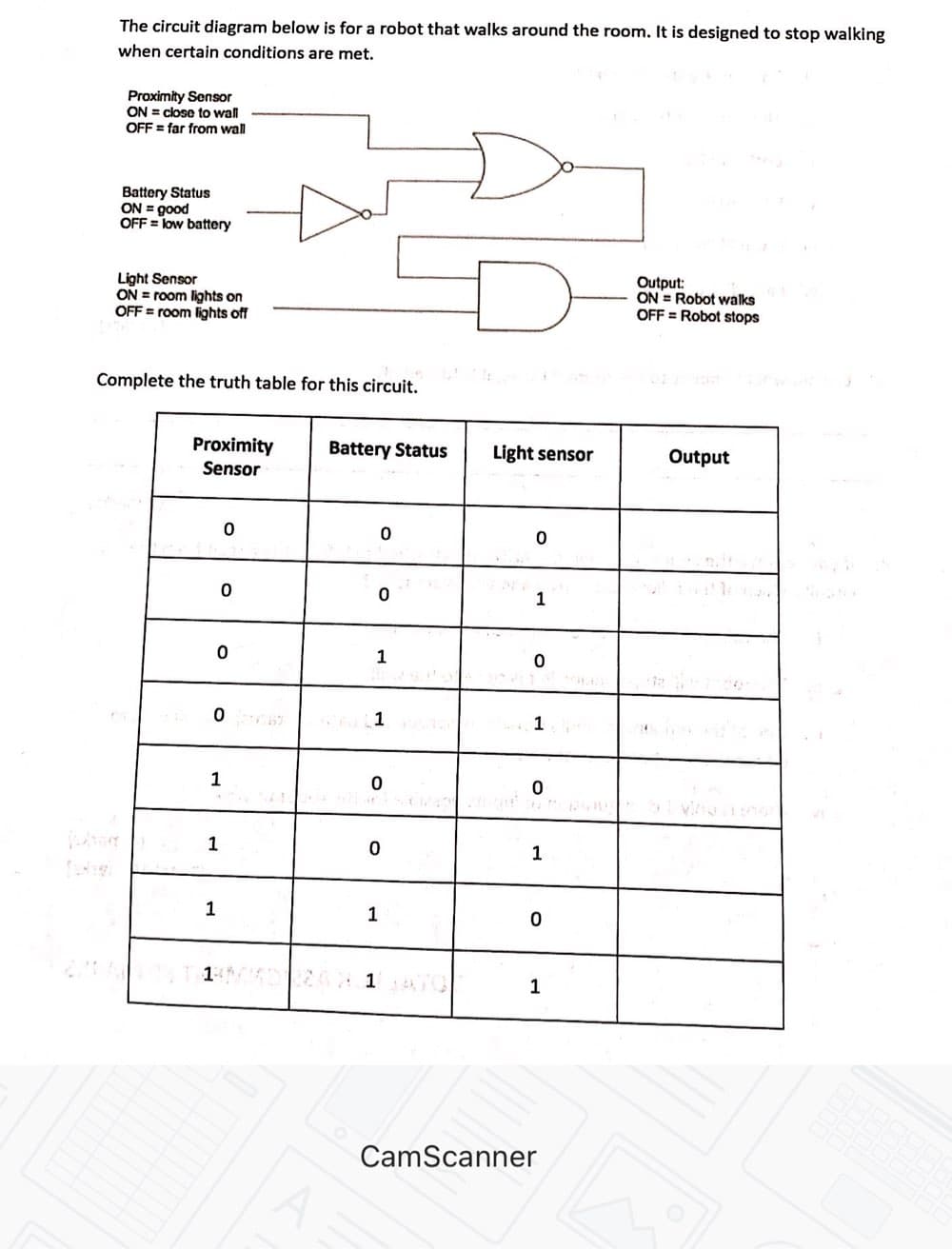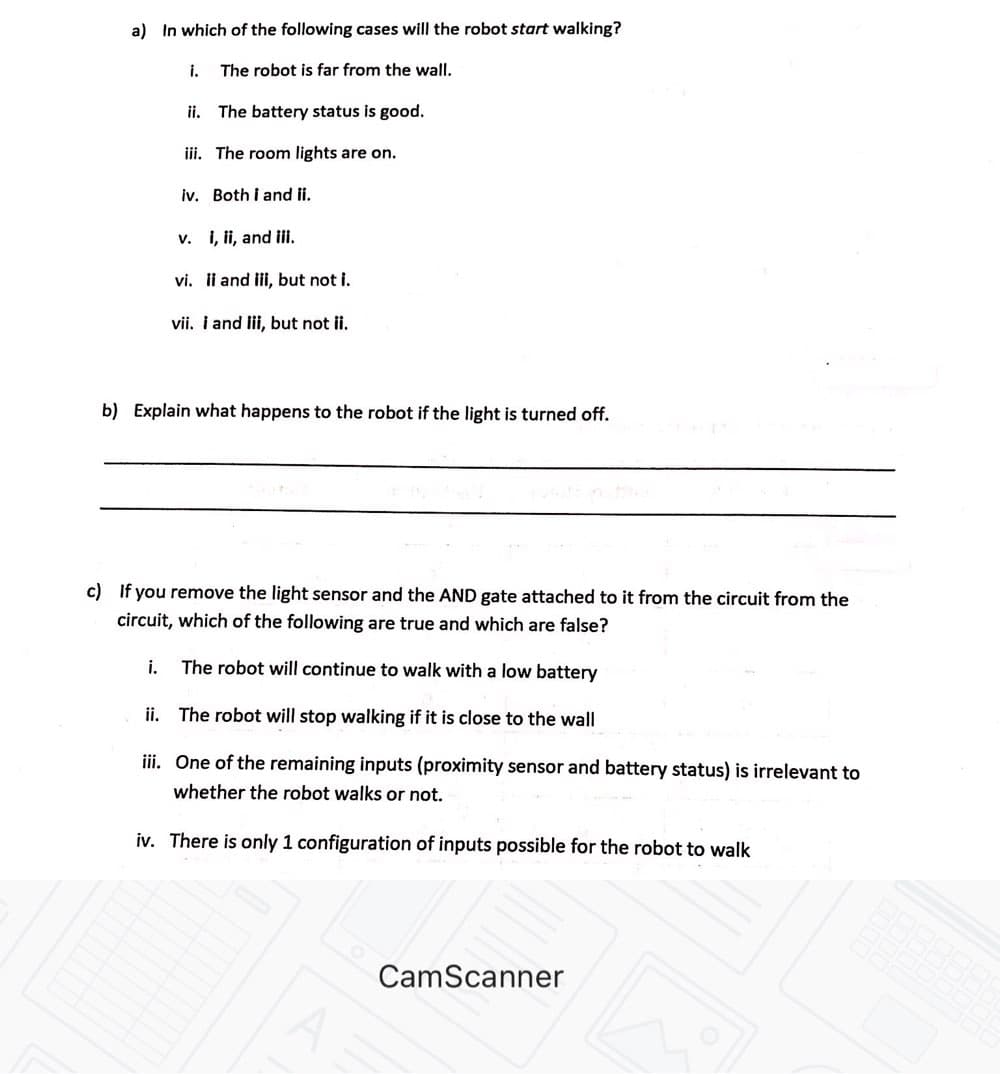a) In which of the following cases will the robot start walking? i. The robot is far from the wall. ii. The battery status is good. iii. The room lights are on. iv. Both i and ii. v. i, ii, and i. vi. ii and iii, but not i. vii. i and lii, but not ii. b) Explain what happens to the robot if the light is turned off. c) If you remove the light sensor and the AND gate attached to it from the circuit from the circuit, which of the following are true and which are false? i. The robot will continue to walk with a low battery ii. The robot will stop walking if it is close to the wall iii. One of the remaining inputs (proximity sensor and battery status) is irrelevant to whether the robot walks or not. iv. There is only 1 configuration of inputs possible for the robot to walk
a) In which of the following cases will the robot start walking? i. The robot is far from the wall. ii. The battery status is good. iii. The room lights are on. iv. Both i and ii. v. i, ii, and i. vi. ii and iii, but not i. vii. i and lii, but not ii. b) Explain what happens to the robot if the light is turned off. c) If you remove the light sensor and the AND gate attached to it from the circuit from the circuit, which of the following are true and which are false? i. The robot will continue to walk with a low battery ii. The robot will stop walking if it is close to the wall iii. One of the remaining inputs (proximity sensor and battery status) is irrelevant to whether the robot walks or not. iv. There is only 1 configuration of inputs possible for the robot to walk
C++ for Engineers and Scientists
4th Edition
ISBN:9781133187844
Author:Bronson, Gary J.
Publisher:Bronson, Gary J.
Chapter11: Introduction To Classes
Section11.5: A Closer Look: Uml Class And Object Diagrams
Problem 2E
Related questions
Question

Transcribed Image Text:The circuit diagram below is for a robot that walks around the room. It is designed to stop walking
when certain conditions are met.
Proximity Sensor
ON = close to wall
OFF = far from wall
Battery Status
ON = good
OFF = low battery
Light Sensor
ON = room lights on
OFF = room lights off
Output:
ON = Robot walks
OFF = Robot stops
Complete the truth table for this circuit.
Proximity
Sensor
Battery Status
Light sensor
Output
1
1
1
1
1
1
1
1-
1
1
CamScanner

Transcribed Image Text:a) In which of the following cases will the robot start walking?
i.
The robot is far from the wall.
ii. The battery status is good.
ii. The room lights are on.
iv. Both i and ii.
v. i, ii, and ii.
vi. ii and ii, but not i.
vii. i and lii, but not ii.
b) Explain what happens to the robot if the light is turned off.
c) If you remove the light sensor and the AND gate attached to it from the circuit from the
circuit, which of the following are true and which are false?
i. The robot will continue to walk with a low battery
ii. The robot will stop walking if it is close to the wall
iii. One of the remaining inputs (proximity sensor and battery status) is irrelevant to
whether the robot walks or not.
iv. There is only 1 configuration of inputs possible for the robot to walk
CamScanner
Expert Solution
This question has been solved!
Explore an expertly crafted, step-by-step solution for a thorough understanding of key concepts.
This is a popular solution!
Trending now
This is a popular solution!
Step by step
Solved in 3 steps with 3 images

Knowledge Booster
Learn more about
Need a deep-dive on the concept behind this application? Look no further. Learn more about this topic, computer-science and related others by exploring similar questions and additional content below.Recommended textbooks for you

C++ for Engineers and Scientists
Computer Science
ISBN:
9781133187844
Author:
Bronson, Gary J.
Publisher:
Course Technology Ptr

C++ for Engineers and Scientists
Computer Science
ISBN:
9781133187844
Author:
Bronson, Gary J.
Publisher:
Course Technology Ptr